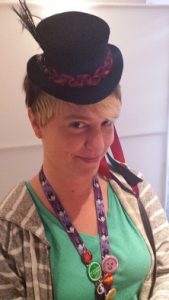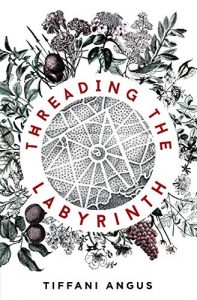Threading the Labyrinth of Historical Research: How the twists and turns led to a Creative Writing PhD
[Part II after “Doing a PhD in Creative Writing: Is it for Everyone?”]
by Dr Tiffani Angus
 Last year I wrote an article of advice about Creative Writing PhDs. The full story of how I wrote Threading the Labyrinth as part of my PhD is too long and complex to recount here; after all it took five years and I also wrote a 40,000-word analysis of the process! But I can share how an idea blossomed into a novel spanning 400 years. Threading started a decade ago as a vague project proposal: “For the fiction portion of the dissertation, I propose to write a historical fantasy novel (working title The Grene Altar) based on English gardening styles and philosophy from the early seventeenth century through today.”
Last year I wrote an article of advice about Creative Writing PhDs. The full story of how I wrote Threading the Labyrinth as part of my PhD is too long and complex to recount here; after all it took five years and I also wrote a 40,000-word analysis of the process! But I can share how an idea blossomed into a novel spanning 400 years. Threading started a decade ago as a vague project proposal: “For the fiction portion of the dissertation, I propose to write a historical fantasy novel (working title The Grene Altar) based on English gardening styles and philosophy from the early seventeenth century through today.”
That’s it: no idea of protagonists or storylines. I knew that I wanted to write the novel in sections—late Tudor/early Stewart, Georgian, Victorian, World War II, and 2010—but I didn’t know anything more specific.
It was time to do some research!
Any historical fiction author worth their salt loves research; it’s the wild goose chase that takes you from thinking about Victorian photography to trying to discover exactly how chemists made the purple liquid for the window’s carboys display to figuring out what medicines from the 1860s people used regularly that contained currently controlled substances. Writing a novel covering 400 years could easily get out of control.
I follow two guidelines when writing historical fiction:
- Research as catalyst. I often find story ideas by reading about certain times and places, looking at art and considering not just the story on the canvas but the one behind its creation, and pondering artefacts in museums (Who used this spoon? Who made this dress?). I had time periods; I just had to find the stories within them.
- Creativity is Problem Solving. The pitch I made meant that I had some restrictions. Restrictions, however, are a GOOD THING! Give yourself restrictions and your brain will try to figure out a way to solve the puzzle. And Threading, a novel about 400 years in the same garden where characters timeslip forward and backward, was definitely a puzzle.
 Both guidelines worked for my needs with Threading because the starting point was the garden: I could use my research into gardening history to begin to create the characters who lived there during each time, and being “stuck” in a garden meant I had to solve the puzzles of how they were connected to this place. The added restriction of focusing mainly on women who would have worked in the garden was an additional restriction.
Both guidelines worked for my needs with Threading because the starting point was the garden: I could use my research into gardening history to begin to create the characters who lived there during each time, and being “stuck” in a garden meant I had to solve the puzzles of how they were connected to this place. The added restriction of focusing mainly on women who would have worked in the garden was an additional restriction.
To better understand the process, I’ll revisit how the earliest section of the novel developed. The protagonist of the 1620s section was born when I found the names of two weeding women on the labourer lists for the Hampton Court Palace gardens during Henry VIII’s reign: I combined their names and ended up with Joan Cookstole who does “stump work” in my manor house’s gardens.
But it needed more: she needed a purpose, a motivation. I then researched not just the gardening of the time but also common seventeenth-century foods, simples and “receipts” of the time, early garden book publishing, clothing, and so much more. Joan started to take shape: I married her to the orchardman, gave her a sick infant, and made her slightly literate to match her station and background. For conflict, I created strife in the marriage due to her son’s illness and her husband’s unhappiness about his position in the garden, and then increased it by adding a mysterious new head gardener.
But something was still missing. That’s where I turned to garden book publishing of the sixteenth and seventeenth centuries. Many early gardening guides used the word “secret” in the title as a selling point, and the new gardener brings a book to the garden—a book that Joan finds. Boom. There was my main catalyst: Joan needs those secret recipes to heal her son, she needs to discover the secret of making her husband love her again, and she needs to learn the secret of the walled garden where she hears voices and sees images that make no sense.
The dissertation also included a critical commentary; the research I did for the fiction fed into the analysis, and the research I did for the analysis—about space and time in gardens in fantasy fiction—fed into the novel. I read every fantasy book I could get my hands on that was set in a garden (this ended up mainly being children’s literature, often featuring time travel), and about theories of space and time (borders, polders, heterotopias, chronotopes, palimpsests, the hortus conclusus, and spatialization), the border between historical fiction and fantasy, the various types of time travel in fiction, the composite novel and how to structure and sequence a novel of five parts, and the pursuit of perfection in creation. It all fed into each other.
It’s in this way that I wrote Threading the Labyrinth; the action of threading a labyrinth is walking its twists and turns until you get to the centre, and then following that path back to where you began. Writing Threading was much the same: I had to follow all of the twists and turns of research, writing and rewriting, analysing my writing to better understand what I had done and what I had ended up with, and then, once I passed my viva, revisiting the book to make it publishable and better fit my publisher’s vision of what readers wanted.
Ultimately, doing this PhD was about my job as writer to know my story. This isn’t to say that a degree is necessary or that we should babble to whoever will listen about the ins and outs of the writing process, but rather that we should fully understand why we have made the writerly choices we have made. It helps us write better stories that readers not only enjoy but also, hopefully, find some depth to—stories that they think about long after finishing.
Bio:
Tiffani Angus is a Senior Lecturer at Anglia Ruskin University, Cambridge, UK, who lectures in Publishing and Creative Writing, is the Course Leader for the MA Creative Writing, Co-Course Leader for the MA Publishing, and is General Director of the Anglia Centre for Science Fiction and Fantasy. She has published short fiction in a variety of genres (among them science fiction, historical fantasy, horror, and even erotica) and her debut novel Threading the Labyrinth is out with Unsung Stories Press. Her current work in progress is novel inspired by her research into the estrangement of women’s bodies in apocalyptic fiction. An American who grew up in Las Vegas, she now lives in Bury St Edmunds with her partner.
She can be found on Twitter @tiffaniangus, Instagram at doc_tiff and on Facebook
Her website is at www.tiffani-angus.com
She can be found on Twitter @tiffaniangus
Her website is at www.tiffani-angus.com
THREADING THE LABYRINTH, Tiffani Angus
 American owner of a failing gallery, Toni, is unexpectedly called to England when she inherits a manor house in Hertfordshire from a mysterious lost relative.
American owner of a failing gallery, Toni, is unexpectedly called to England when she inherits a manor house in Hertfordshire from a mysterious lost relative.
What she really needs is something valuable to sell, so she can save her business. But, leaving the New Mexico desert behind, all she finds is a crumbling building, overgrown gardens, and a wealth of historical paperwork that needs cataloguing.
Soon she is immersed in the history of the house, and all the people who tended the gardens over the centuries: the gardens that seem to change in the twilight; the ghost of a fighter plane from World War Two; the figures she sees in the corner of her eye.
A beautiful testament to the power of memory and space, Threading the Labyrinth tells the stories of those who loved this garden across the centuries, and how those lives still touch us today.
BUY THE BOOK HERE
Book depository; (paperback; free shipping worldwide)
https://www.bookdepository.com/Threading-Labyrinth-Tiffani-Angus/9781912658091
Unsung Stories (ebook and paperback)
Category: On Writing
























